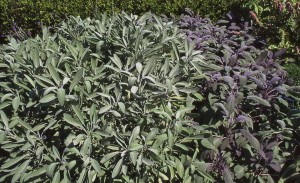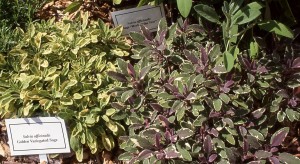Growing Sage ( salvia officinalis)
“How can a man grow old who has sage in his garden” was a proverb used in China and Persia and parts of Europe. Sage was much prized by the Chinese as money and would trade three chests of tea for one chest of sage leaves. The ancients claim sage increase mental ability.
Today we can grow garden sage in our gardens and it is used in a number of ways, such as decorative, culinary, around the house, cosmetic and medicinal. If you have cooked a turkey you may have heard of sage.
Growing Sage:
Site: Hardy soft evergreen silver shrub which grows about 1 to 2 feet and likes full sun to part shade and likes light, dry, alkaline and well drained soil. Zones 4-8 and is drought-tolerant and low maintenance with soil pH 6.0-6.7
This Mediterranean plant has pretty little blooms in pink, lavender, purple, and white. Usually blooms in late spring or early summer. Garden sage has violet blue flowers which attract bees, and humming birds.
Growing: Garden sage can be grown from seed; most of the sages that are variegated should only be grown from cutting, layering and division. Sage seeds do not store well, so use fresh seeds. Sage should be cut back after flowering, to keep it bushy and replace every few years as it get too woody.
Uses: Around the house, use it in wreaths, herbal hair rinses, astringents, toothpowders, dusting powder and in mouthwashes. It is added to homemade perfumes, soaps, and cosmetics. Sage is one of the herbs used in hair rinses for dark hair.
Culinary: Most of us like sage with poultry, but it is wonderful with so many other dishes. Great with rich, fatty meats, pork, sausage, cheese, butters, and fry the whole leaves as an appetizer. Sage has a lemony but camphor like bitter taste. Young leaves can be eaten in salads or cooked with eggs. Flavored sage such as clary and pineapple sage can be substituted for most culinary dishes. Dried sage has a different flavor than fresh; it is less lemony and may even taste a little musty.
Garden sage is the one most cooks used because it will retain its flavor through longer cooking periods and dries great.
Harvest: Snip fresh leaves as needed or bunch them together and hang to dry inside of a paper bag with holes punch in the bag. Or you can freeze the leaves. Avoid harvesting fully the first year. Pick sage leaves just before flowers appear and dry leaves slowly to preserve the flavor.
Medicinal: Sage will aid in digestion and is antiseptic, antifungal, and contains estrogen. Suffers of diarrhea may want to make a tea of sage. Just be aware, sage does not make a great tasting tea. Sage in dishes is strong and favorable and will help to digest fatty foods. Sage is said to help with sore throats, mouth irritations and cut and bruises. Research has revealed sage may lower blood sugar.
There are dozen if not hundreds of sage both perennial and annual. Some of my favorite includes tricolor sage, clary sage, purple sage, golden sage, pineapple sage, Mexican blue sage and blue sage.
Companion plants: Sage is good with rosemary, lavender, marjoram and thyme. It may repel the cabbage butterfly. Plant with cabbage, carrots, strawberries, and tomatoes; avoid planting with cucumbers and onions.



